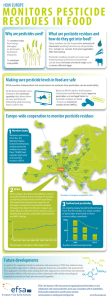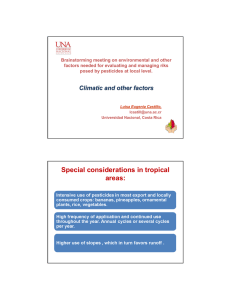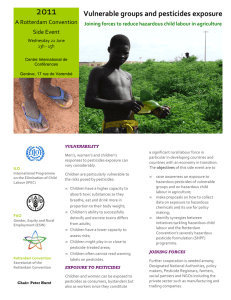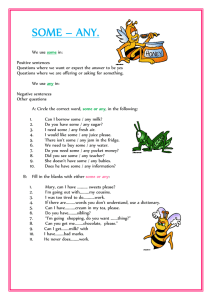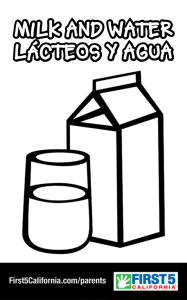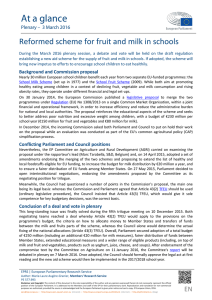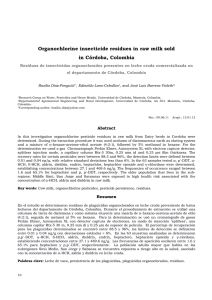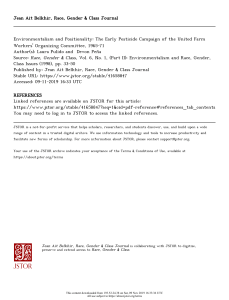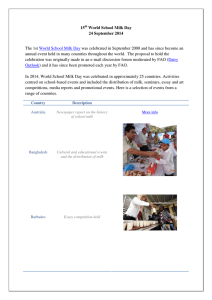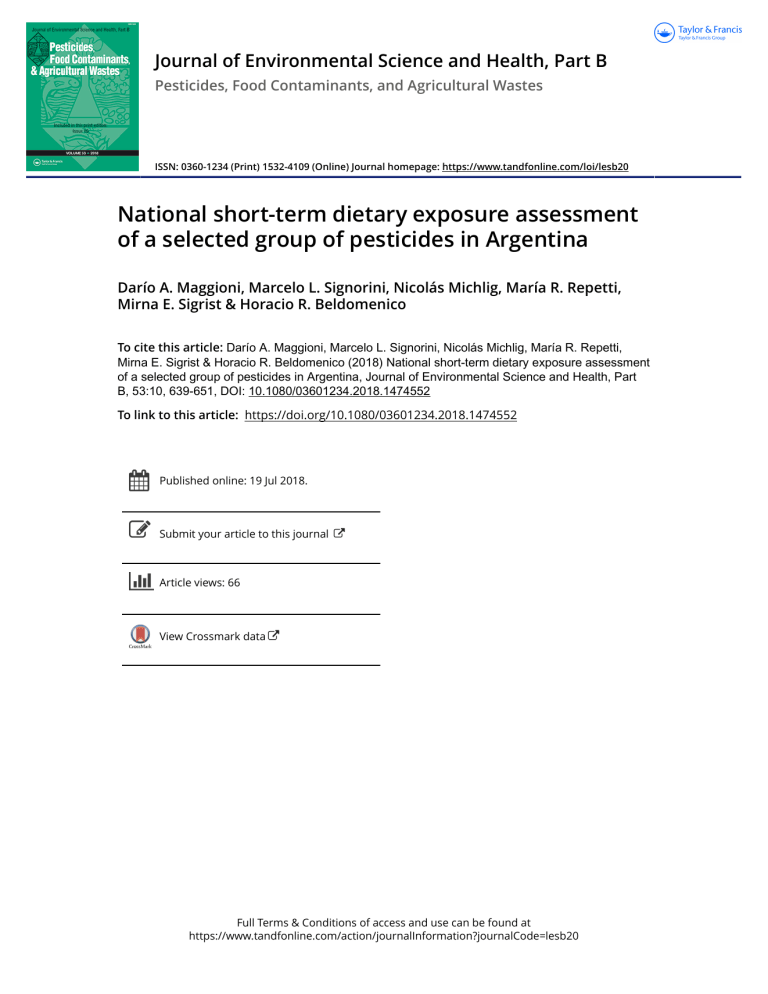
Journal of Environmental Science and Health, Part B Pesticides, Food Contaminants, and Agricultural Wastes ISSN: 0360-1234 (Print) 1532-4109 (Online) Journal homepage: https://www.tandfonline.com/loi/lesb20 National short-term dietary exposure assessment of a selected group of pesticides in Argentina Darío A. Maggioni, Marcelo L. Signorini, Nicolás Michlig, María R. Repetti, Mirna E. Sigrist & Horacio R. Beldomenico To cite this article: Darío A. Maggioni, Marcelo L. Signorini, Nicolás Michlig, María R. Repetti, Mirna E. Sigrist & Horacio R. Beldomenico (2018) National short-term dietary exposure assessment of a selected group of pesticides in Argentina, Journal of Environmental Science and Health, Part B, 53:10, 639-651, DOI: 10.1080/03601234.2018.1474552 To link to this article: https://doi.org/10.1080/03601234.2018.1474552 Published online: 19 Jul 2018. Submit your article to this journal Article views: 66 View Crossmark data Full Terms & Conditions of access and use can be found at https://www.tandfonline.com/action/journalInformation?journalCode=lesb20 JOURNAL OF ENVIRONMENTAL SCIENCE AND HEALTH, PART B 2018, VOL. 53, NO. 10, 639–651 https://doi.org/10.1080/03601234.2018.1474552 National short-term dietary exposure assessment of a selected group of pesticides in Argentina Darıo A. Maggionia, Marcelo L. Signorinib, Nicolas Michliga, Marıa R. Repettia, Mirna E. Sigrista, and Horacio R. Beldomenicoa a Program of Research and Analysis of Chemical Residues and Contaminants (PRINARC), Faculty of Chemical Engineering, National University of Littoral, Santa Fe, Argentina; bInstituto Nacional de Tecnologıa Agropecuaria, EEA Rafaela, Santa Fe, Argentina ABSTRACT ARTICLE HISTORY An evaluation of acute dietary exposure to pesticide residues, applying deterministic and stochastic methods, was performed for a selected group of pesticides in two representative age groups from Argentina. Thus, 28 active ingredients (a.i.) and 75 food items were evaluated for the group of 2–5-yearold children, while 9 a.i. and 59 food items were considered for the 10–49-year-old women group. A deterministic assessment was conducting following the Food and Agriculture Organization (FAO) and World Health Organization (WHO) procedure but using the national maximum residue limits (MRLs) as pesticide residue concentration data, while in the stochastic approach, a theoretical distribution modeled with the available information was used. Food consumption data were obtained from the 2004–2005 comprehensive national nutrition and health survey. The risk was estimated by comparing the short-term dietary exposure with the acute reference dose (ARfD) values for each pesticide-food combination evaluated. In the deterministic assessment, 173 (39.1%) and 40 (31.3%) combinations exceeded the ARfD thresholds for the 2–5-year-old children and 10–49-year-old women groups, respectively. This conservative study generated relevant information as a first stage of acute dietary risk assessment in Argentina. Received 6 December 2017 Accepted 3 May 2018 Introduction Pesticides are widely used in modern agriculture to obtain high crop yields and to prevent major crop losses. It is well known that the use of pesticides in crops (or raw agricultural commodities) and those crops later feed to animals can lead to the presence of residues in foodstuffs. This important drawback of pesticide use can cause potential human health risks.[1] Argentina is a food-producing country, both for export and for domestic consumption. Among the main extensive crops are soybeans, corn, wheat, and sunflowers. The production of which has been increasing in the last 10 years. In the 2015/2016 season, approximately 20.5 million ha of soybean and another 12.7 million ha of the other three aforementioned cultures were planted.[2] Fruit and vegetables are also produced mostly to meet the national demand. Concomitantly, increased use of pesticides was steadily observed, with the total volume of pesticides sales increasing from 123.8 million kg in 1997 to 281.6 million kg in 2013, with herbicides being the group of pesticides leading the market.[3] In 2010, Argentina established for the first time its own maximum residue limits for about 420 pesticides and related compounds. This list was supplemented in 2012 through a resolution that extended the authorizations of some active ingredients previously KEYWORDS Acute risk assessment; dietary exposure; pesticide residue; stochastic modeling; ARfD authorized in 2010, especially for minor or unprotected crops. The MRLs were established by residues’ evaluation based on Supervised Field Trials, Good Agricultural Practices and Good Laboratory Practices requirements, and using the Organisation for Economic Co-operation and Development (OECD) calculator.[4,5] In addition to their use as agronomic tools, pesticides also have urban and home uses, combating vectors and implementing hygiene practices and disease prevention. Many people are exposed to these substances in an almost unavoidable manner. Some epidemiological studies have linked this exposure with the incidence of neurological disorders.[6] Furthermore, there are a variety of mechanisms by which pesticides can potentially initiate or promote immunotoxicity and hormonal disruption or can compromise health with their carcinogenic and mutagenic effects, among other human health concerns.[7,8] Currently, different chemical families of herbicides, insecticides, and fungicides are used, and some of them have very similar mechanisms of action. The organophosphorus and carbamate insecticides, as acetylcholinesterase (AChE) inhibitors, can alter neurological development and cause neurobehavioral impairments in humans, and they are among the most acute toxic pesticides available in the market.[9] In addition, human poisoning with agricultural pesticides has been reported.[10,11] Therefore, the CONTACT Horacio R. Beldomenico hbeldo@fiq.unl.edu.ar Program of Research and Analysis of Chemical Residues and Contaminants (PRINARC), Faculty of Chemical Engineering, National University of Littoral, Santiago del Estero 2654, C.P. 3000, Santa Fe, Argentina. Color versions of one or more of the figures in this article can be found online at www.tandfonline.com/lesb. © 2018 Taylor & Francis Group, LLC 640 D. A. MAGGIONI ET AL. health risks associated with this problem are of great toxicological and regulatory concern, and they increasingly demand scientific research.[12] The assessment of consumer exposure in the context of risk analysis, as a process for controlling situations in which an organism, system, or subpopulation could be exposed to a chemical hazard, arises as an adequate tool to protect the health of the population and to minimize the undesirable effects of the use of pesticides in the environment.[13,14] Short-term (acute) dietary exposure assessment has become as a necessity that justifies a detailed follow-up of the risk caused by high intake of a pesticide residue in a short period of time. In 1997, the World Health Organization (WHO) published guidelines for predicting dietary intake of pesticide residues, in which the issue of acute toxicity of pesticide residues in food was presented.[15] In the same year, the first procedure to assess acute dietary exposure to pesticide residues, applicable both nationally and internationally, was proposed by the Joint FAO-WHO Meeting on Pesticide Residues (JMPR).[16] This methodology was subsequently updated by the JMPR, and the revised version was published in 2009.[17] This method has been applied by the JMPR to conduct the periodic International Estimate of Short-Term Intake (IESTI) of pesticide residues. More recently in 2015, in a joint activity involving European Food Safety Authority (EFSA), FAO, WHO, Dutch National Institute for Public Health and the Environment (RIVM) and approximately 20 countries representing European and nonEuropean risk assessment and risk management regulatory bodies, it was proposed a possible revision to the methodology by introducing changes in the equations and their parameters. One of the most important modifications is the application of the MRLs as residue concentration data instead of the HR/ STMR, corrected by conversion factors to convert the residue to match the residue definition used in dietary intake assessments and processing factors from the raw to the edible portion, when corresponding, and averaging the variability factor to 3 in acute assessments.[18] This new proposal to modify the methodology, which has not yet materialized, has given rise to a strong debate in different forums in which pesticide manufacturers and registrants also participate.[19] In a recently published study, our group conducted a chronic dietary risk assessment in which 308 pesticides were evaluated for four age groups from the Argentina population.[20] As a result, some compounds were identified as of the greatest concern in terms of chronic risk. Based on these results and due to the absence of scientifically based information in the country on acute dietary exposure, it was decided to conduct this evaluation to determine whether these pesticides could also raise concerns in terms of short-term dietary exposure. Thus, the objective of our study was to perform a deterministic and stochastic evaluation, for the first time in this country, of acute dietary exposure to 28 and 9 pesticides for groups of 2–5-year-old children and 10–49-year-old women, respectively. A total of 76 food items were included. A comparison of the exposure obtained through deterministic and stochastic approaches was performed. Materials and methods Deterministic (point estimates) dietary intake assessment The deterministic risk assessment was performed following the FAO-WHO methodology recommended in 2009 (Fig. 1a).[17] In our work, the National Estimate of Short-Term Intake (NESTI) was calculated using MRL values in all cases, due to the lack of complete information on Highest Residue (HR) and Supervised Trials Median Residue (STMR) nationwide (Fig. 1b). Processing factors were not considered, nor were the MRL values recalculated for the residue definition for risk assessment because the lack of a complete database of conversion factors. The same equation was used for the calculation of the 1 and 3 cases (Fig. 1b), and this equation was applied when the commodity unit weight of the edible portion (U) was less than 0.025 kg and when a raw agricultural commodity or processed commodity was bulked or blended (e.g., cereal grains, oilseeds, and pulses). This equation was also applied to meat, animal fat, eggs, milk, and dairy products. Case 2 was applied for a single piece of fruit or a vegetable with U greater than 0.025 kg. In addition, when the U value was less than or greater than the large portion (LP) (see definition below), cases 2a or Figure 1. Equations used for the estimation of acute dietary exposure. (a) FAO-WHO[17] recommended procedure for estimation of acute dietary exposure; (b) procedure for estimation of acute dietary exposure applied in this work. JOURNAL OF ENVIRONMENTAL SCIENCE AND HEALTH, PART B 2b were used, respectively (Fig. 1b). The Argentinean MRLs were obtained from the National Food Safety and Quality Service (SENASA) resolutions 934, 559, and 608, issued in 2010, 2011, and 2012, respectively, and from chapter 8 of the Argentinean Food Codex (CAA).[4,5,21,22] A variability factor (v) of 3 was applied in the equations for cases 2a and 2b to consider the variability of residues between different crop units. The food consumption data were obtained from the National Nutrition and Health Survey (ENNyS) conducted by the National Health Ministry of Argentina in 2004–2005 and issued in 2007 and 2012.[23,24] The methodology used to collect consumption data was 24-h recall. All food intake during the day before the survey, including drinks (except water and infusions), was recorded. The information for the 2–5-year-old children group and 10–49-year-old women group were obtained from a total of 409,360 responses requested in 311,182 homes from the 23 provinces of Argentina.[23,24] The large portion (LP) values included in equations were obtained considering the 97.5th percentile (P97.5) (kg day¡1) from the distribution of these data of consumption (consumers only). Some of the total 76 food items included in the study were grouped by similarity to foods that also had the same MRL to facilitate the handling of this large amount of information (Table 1). Foods of plant origin were grouped as follows: apple (total), which included the consumption data on apples with skins and without skins; corn (total), which included consumption of fresh corn, corn flour, whole grain corn, and corn starch; rice (total), including brown rice and rice flour; soybeans (total), including soybeans and soy flour; and sugar (total), including white sugar and brown sugar. In the case of food of animal origin, the different cuts of beef were grouped as meat (total), as well as some dairy products, such as milk and cheese. Both types of dairy products were grouped according to their fatty content (whole, low-fat, and skimmed). Thus, the different types of whole milk (powdered and fluid milk) and whole yogurts were grouped under the name of whole milk (total), and the same criterion was applied for partially skimmed milk, which was grouped as low-fat milk (total), and skimmed milk, grouped as skim milk (total). In the case of cheeses, the different types of cheeses were grouped as whole-milk cheeses (total), low-fat cheeses (total), and skim cheeses (total). Values of the unit weights of the edible portion (U) (kg), not yet available in our country, were extracted from the Joint FAOWHO Meeting on Pesticide Residues (JMPR) evaluations.[25–27] A body weight of 60 kg was assumed for the group of 10–49year-old women, whereas for the 2–5-year-old children group, 641 15.4 kg was used. The children’s body weights were estimated using the Argentinean guidelines for the evaluation of growth.[28] Stochastic dietary intake assessment Food consumption, as well as food residue concentration data, has high variability, which is why the use of methodologies to account for this variability has been encouraged internationally when risk assessments are conducted.[29] The stochastic exposure assessment was performed using the @Risk software package (version 7.5, Palisade Corporation, Ithaca, NY, USA). Food consumption was modeled with a lognormal distribution, using the mean and standard deviation for each food evaluated obtained from the ENNyS (Fig. 2a). The residue concentration was modeled by a PERT distribution, with the minimum value equal to 0, the most probable (average) value equal to the MRL, and the maximum value modeled using a Gamma distribution up to a maximum value equal to three times the MRL. The Gamma distribution was included in this second-order distribution with the aim of considering that a certain percentage of the analyzed samples (which we defined as approximately 5% of samples) could have a concentration of residues up to a maximum equal to three times the value of the MRL. There were not local data to support these parameters, so the Gamma distribution was modeled to consider uncertainty about the prevalence of samples with residue concentrations higher than the MRL (Fig. 2b). In the absence of specific national data on the concentration of pesticide residues evaluated in different foods, it was considered that the concentration of these residues could be up to three times the MRL value in the 5% of samples. We estimate that these adopted values, even assuming that they are uncertain, are sufficiently conservative for the construction of the stochastic model. The outputs of the model were the National Estimate of Short-Term Intake (NESTI) (mg kg¡1 bw day¡1) (Fig. 2c) and the percentage of probability (%Prob) that the exposure to a pesticide-food combination exceeds 100% of ARfD (Fig. 2d). To generate all possible exposure scenarios, 10,000 iterations with Latin hypercube sampling of each model were conducted. Acute reference dose (ARfD) sources The acute reference dose of a chemical is an estimate of the amount of a substance in food and/or drinking-water, normally expressed on a body-weight basis, that can be ingested in a period of 24 h or less without appreciable health risk to the Table 1. Identification of the 76 food items included in the study. Food groups n Food items Meat and meat products Milk and dairy products 3 9 Bovine fat, egg, meat (total) Butter, low-fat cheese (total), low-fat milk (total), milk cream, ricotta, skim cheese (total), skim milk (total), wholemilk cheese (total), whole milk (total) Apple (total), apricot, banana, cherry, grapefruit, kiwi, lemon, mandarin, melon, orange, peach, pear, pineapple, plum, prune, quince, strawberry, table grape, watermelon Artichoke, asparagus, beets, broccoli, Brussel sprouts, cabbage, carrot, cauliflower, celery, chicory, cucumber, eggplant, escarole, globe squash, leek, lettuce, onion, pumpkin, potato, spinach, sweet potato, Swiss chard, tomato Almond, avocado, bean, broad bean, corn (total), fresh pea, green bean, green olive, lentil, olive oil, peanut, rice (total), soybean (total), soybean oil, sugar (total), sunflower oil, vegetable oil mixture, walnut, wheat grain, wheat flour, white rice, whole wheat flour Fruits 19 Vegetables 23 Other (miscellaneous) 22 642 D. A. MAGGIONI ET AL. Figure 2. Example of inputs and outputs of the stochastic model for captan-peach combination in the 2–5-year-old children group. (a) Input lognormal adjustment of peach consumption; (b) input theoretical model of captan residue in peach; (c) output of NESTI (mg kg¡1 bw day¡1); (d) output of cumulative exposure expressed in terms of %ARfD. consumer, on the basis of all of the known facts at the time of the evaluation.[30] In this study, different sources of the ARfD were consulted, and the lowest ARfD value available for each pesticide was used. Data from the European Food Safety Agency (EFSA), Joint FAO/WHO Meeting on Pesticide Residues (JMPR), EU directives (DIR), Draft Assessment Report (DAR), and Standing Committee on Plants, Animals, Food and Feed (SCoPAFF) were extracted from the EURL pesticides database.[31] Data from the IUPAC Pesticide Properties Database (PPDB) and European Union (EU) Pesticide database were also consulted.[32,33] Results and discussion Deterministic assessment of acute dietary exposure The deterministic analysis of the children’s group showed that 23 compounds exceeded 100% of the ARfD in at least one pesticide-food combination (Table 2). Compounds such as carbofuran, methyl bromide, oxydemeton-methyl, paraquat dichloride, and procymidone showed maximum values greatly exceeding the ARfD thresholds (> 2000% ARfD). Another group of compounds with elevated exposures consisted of carbaryl, carbendazim, methamidophos, and prochloraz, with %ARfD values in the range of 1,000–2,000%. Table 2 also shows 14 active ingredients (a.i.) with exposures greater than 100% ARfD, whereas chlorothalonil, diazinon, dicofol, fipronil, and thiram did not exceed the acute reference dose. The results for the adult women’s group showed that carbofuran and methyl bromide exhibited the same great excesses verified in the children’s group. Another group of five a.i. exceeded 100% of the ARfD, ranging from 105 to 960%, whereas diazinon and dichlorvos did not exceed the ARfD values (Table 3). In Table 4, all of the foods can be observed corresponding to pesticides exceeding %ARfD for the two age groups evaluated. In the group of children aged 2–5-year-old, there is a generalized excess of the ARfD. These excesses have different levels, and in some cases, they are very high (> 2,000%). This situation could be due to some of the characteristics of the model used to estimate short-term exposure, which was conservative in the estimation of some variables. Using the MRLs as residue concentration data for all of the cases could generate high exposure values.[17] The same situation could occur when processing factors are not systematically applied when considering a processed food or those that are consumed after some preparation or even peeled. Several studies have shown that the application of treatments and even the storage of some foods under determined conditions can reduce the concentrations of certain pesticide residues.[34–39] Additionally, considering a variability factor of the concentration of residues (v) of 3, applied directly to the MRL, could overestimate the true exposure to plant foods, although it is known that, in some cases, the variability of the residues can be even greater.[40] In addition, grouping certain foods of the same type as in the case of milk could lead to very high food consumption values (large portion). In the specific case of the whole milk total, the LP used was the sum of all of the food items considered, which was extremely high (7.806 kg day¡1), and it is unlikely that a child of 2–5-year-old could consume that amount of milk in a single day. However, the LP value of 3.235 kg day¡1 used by the JMPR for wholemilk total, in its periodic international evaluation in 2014, for the group older than 2 years of age could also be considered very high.[25] Nevertheless, in our evaluation only carbofuran had an extremely high exposure (16,907% of the ARfD) for this JOURNAL OF ENVIRONMENTAL SCIENCE AND HEALTH, PART B 643 Figure 3. Comparative chart of the number of times each food was evaluated (“n total” in blue) vs the number of times that the same food for the given compounds under study exceeded the deterministic %ARfD (“n exceeding” in red), in decreasing order of the number of excesses, for the 2–5-year-old children group. type of milk. This is due to the high acute toxicity of this compound which leads to unacceptable exposures that are independent of concentration, consumption (LP), and food. For the remainder of the foods grouped as a total, which can be seen in Table 1, the LP values used in this work were very close to those used by the JMPR evaluations.[25–27] A situation of really concern on the evaluation of carbofuran was that, of the 13 foods considered for this compound, all of them exceeded 100% of the ARfD. This fact can be attributed to it being an extremely toxic compound and therefore having an ARfD assigned by EFSA[31] of 0.00015 mg kg¡1 bw day¡1, in addition to being totally prohibited in the European Union.[33] 644 D. A. MAGGIONI ET AL. Table 2. List of 28 evaluated pesticides and the deterministic and stochastic results obtained for the 2–5-year-old children group. Deterministic Pesticide Azocyclotin Bitertanol Captan Carbaryl Carbendazim Carbofuran Chlorothalonil Cyhexatin Diazinon Dichlorvos Dicofol Dimethoate Disulfoton Endosulfan Fenamiphos Fipronil Methamidophos Methyl bromide Oxydemeton-methyl Paraquat dichloride Phorate Phosmet Pirimiphos-methyl Prochloraz Procymidone Propineb Thiram Ziram n totala n excessb %ARfD Minc–Maxd 12 3 19 30 38 13 26 6 22 5 22 25 4 46 10 9 19 5 15 23 4 11 11 13 16 8 11 17 7 2 15 18 17 13 0 3 0 3 0 7 1 15 8 0 4 4 12 4 2 6 1 5 14 5 0 7 3.0–790.5 6.3–790.5 11.5–440.5 2.1–1666.1 1.0–1213.1 348.3–>2000 0.1–73.4 3.0–790.5 0.0–94.9 12.0–507.2 0.01–92.7 0.7–395.3 4.0–169.1 0.0–881.1 20.9–429.4 0.1–18.7 3.5–1375.4 76.7–>2000 27.8–>2000 2.1–>2000 8.0–338.1 0.2–878.3 0.0–168.2 0.2–1073.4 78.6–>2000 4.7–309.0 2.0–51.5 3.3–386.2 Stochastic Foodstuffe Apple (total) Apple (total) Watermelon Peach Spinach Whole milk (total) Watermelon Apple (total) Apple (total) Whole milk (total) Table grape Apple (total) Whole milk (total) Watermelon Grapefruit Bovine fat Melon Table grape Apple (total) Rice (total) Whole milk (total) Apple (total) Corn (total) Grapefruit Spinach Table grape Table grape Table grape n excessb %ARfD Minc – Maxd % Probf 7 2 6 13 13 13 0 2 0 1 0 6 0 7 5 0 3 4 10 3 1 6 0 4 11 1 0 3 0.9–484.4 1.6–508.2 4.8–272.0 1.1–1121.0 0.4–679.1 116.8–>2000 0.0–46.8 0.9–484.9 0.0–63.3 3.5–208.6 0.0–38.6 0.2–269.0 1.2–69.6 0.0–598.9 7.4–297.8 0.0–5.3 1.2–1074.6 37.2–>2000 12.6–>2000 0.9–738.8 2.3–139.1 0.1–505.0 0.0–47.2 0.1–638.2 28.2–1131.9 3.5–112.1 0.6–18.7 1.1–140.1 99.5 99.3 99.5 100 100 100 0.2 99.6 9.6 88.4 0.1 96.2 16.3 99.7 95.7 0 99.9 100 100 99.1 70.5 99.8 2.5 100 100 63.1 0 82.8 Foodstuffa Apple (total) Apple (total) Melon Peach Swiss chard Potato Melon Apple (total) Apple (total) Whole milk (total) Peach Tomato Whole milk (total) Melon Grapefruit Bovine fat Melon Avocado Apple (total) Rice (total) Whole milk (total) Apple (total) Corn (total) Grapefruit Swiss chard Peach Peach Table grape ARfD (mg kg¡1 bw day¡1) [Source] 0.02 JMPR[31] 0.01 EFSA[31] 0.3 EFSA[31] 0.01 EFSA[31] 0.02 EFSA[31] 0.00015 EFSA[31] 0.6 JMPR[31] 0.02 JMPR[31] 0.025 EFSA[31] 0.002 EFSA[31] 0.2 JMPR[31] 0.01 EFSA[31] 0.003 JMPR[31] 0.02 JMPR[31] 0.0025 EFSA[31] 0.009 EFSA[31] 0.003 DIR[31] 0.003 EFSA[31] 0.0015 EFSA[31] 0.005 IUPAC[32] 0.003 JMPR[31] 0.045 EFSA[31] 0.15 EFSA[31] 0.025 EFSA[31] 0.012 DAR[31] 0.1 DIR[31] 0.6 DIR[31] 0.08 SCoPAFF[31] a Number of total evaluated pesticide-food combinations. Number of pesticide-food combinations that exceeded 100% of the ARfD (%ARfD). c Minimum value of %ARfD obtained for the pesticide. d Maximum value of %ARfD obtained for the pesticide. e Foodstuff in combination with the pesticide that had the highest ARfD value. f Probability, expressed as a percentage, exceeding 100% of the ARfD for the maximum value of the %ARfD. b For the group of women aged 10–49-year-old, carbofuran also had high exposures, surpassing the ARfD in 10 of the 13 foods considered (Table 3). Other pesticides that cause equal concern, in both evaluated groups, were methyl bromide, and oxydemeton-methyl, which exceeded the acute reference doses in most of the foods evaluated, some with very high values (Tables 2 and 3). These compounds are also banned in the European Union and have very low ARfD values assigned by the EFSA of 0.003 and 0.0015 mg kg¡1 bw day¡1, respectively.[33] Dichlorvos, another compound of great toxicity, was present in the group of children with high exposure values expressed in terms of % ARfD of up to 507%, while in the group of women its highest exposure value was 78.3%. It is important to mention that these four pesticides also had very high values for chronic dietary exposure, exceeding the acceptable daily intake (ADI) for four age groups of the Argentinean population in a recently published chronic risk assessment.[20] Other pesticide inhibitors of acetylcholinesterase included in this study in the group of high exposures of children and presenting numerous excesses of %ARfD were carbaryl, dimethoate, fenamiphos, and phosmet. In addition, there were two other organophosphorus compounds that have also exceeded the ARfD (disulfoton and phorate); however, they have been banned in our country by the National Food Safety and Quality Service (SENASA) since 2010 and 2011, respectively.[41,42] They were only included in the present evaluation because they still have MRLs for milk in chapter 8 of the Argentinean Food Codex.[22] Another particular case was endosulfan, which was completely banned by SENASA more recently in 2013.[43] This organochlorine, which no longer has MRLs in Argentina, was evaluated because it has been widely used in the country, and it is still possible to find residues in some foods due to its high persistence, although there is no available information at the national level about its acute dietary exposure.[44] Finally, there were three fungicides belonging to different chemical families (captan, carbendazim, and procymidone) that exceeded 100% of the ARfD in many of the combinations evaluated for the group of children (Table 2). These numerous excesses could be attributed to the different foods included in this study having been assigned high values of MRLs: 10– 15 mg kg¡1 (captan); 1–10 mg kg¡1 (procymidone); and 0.1– 10 mg kg¡1 (carbendazim).[4,5,22] It is important that countries periodically reassess the values of the maximum residue limits that they have set, considering the results of toxicological studies and risk assessment.[8,45–48] Thus, considering only the pesticides evaluated in this study, we see that there were 14 compounds with authorizations in Argentina that are not approved in the European Union (EU) (Table 5). In the same table, it can also be seen that some of the MRLs established in our country are substantially higher than those of the European Union and even those assigned by Codex Alimentarius. The 13 22 5 25 5 14 10 17 17 Carbofuran Diazinon Dichlorvos Dimethoate Methyl bromide Oxydemeton-methyl Phosmet Procymidone Ziram 10 0 0 2 4 9 3 10 2 n excess 71.0–>2000 0.0–24.6 2.1–78.3 0.2–105.1 39.9–>2000 22.5–958.3 0.1–228.2 23.9–631.0 0.7–125.0 d %ARfD Min – Max c Deterministic Potato Apple (total) Whole milk (total) Tomato Table grape Apple (total) Apple (total) Swiss chard Table grape Foodstuff e c b Number of total evaluated pesticide-food combinations. Number of pesticide-food combinations that exceeded 100% of the ARfD (%ARfD). Minimum value of %ARfD obtained for the pesticide. d Maximum value of %ARfD obtained for the pesticide. e Foodstuff in combination with the pesticide that had the highest ARfD value. f Probability, expressed as a percentage, exceeding 100% of the ARfD for the maximum value of the %ARfD. a n total Pesticide a b 10 0 0 0 4 7 3 6 0 n excess b Table 3. List of nine evaluated pesticides and the deterministic and stochastic results obtained for the 10–49-year-old women group. Stochastic 21.8–>2000 0.0–16.4 0.9–31.5 0.1–72.9 11.1–>2000 7.6–623.4 0.0–130.6 8.0–323.0 0.2–97.5 %ARfD Min – Maxd c 100 0 0.1 16.2 100 99.5 80.3 99.6 47.5 %Probf Potato Apple (total) Whole milk (total) Tomato Avocado Apple (total) Apple (total) Spinach Celery Foodstuffe 0.00015 EFSA[31] 0.025 EFSA[31] `0.002 EFSA[31] 0.01 EFSA[31] 0.003 EFSA[31] 0.0015 EFSA[31] 0.045 EFSA[31] 0.012 DAR[31] 0.08 SCoPAFF[31] ARfD (mg kg¡1 bw day¡1) [Source] JOURNAL OF ENVIRONMENTAL SCIENCE AND HEALTH, PART B 645 646 D. A. MAGGIONI ET AL. Table 4. List of total evaluated pesticides for the two age groups indicating the number of foodstuff that exceeded the deterministic %ARfD (n excess) and the name of each one. 2–5 year-old children Pesticide Azocyclotin n excess Foodstuff n excess Foodstuff 7 Apple (total), lemon, mandarin, melon, orange, pear, whole milk (total) Apple (total), banana Apple (total), apricot, cucumber, eggplant, grape, melon, peach, pear, plum, potato, pumpkin, strawberry, sweet potato, tomato, watermelon Apple (total), bean, cabbage, celery, cucumber, fresh pea, green bean, lettuce, low-fat milk (total), peach, pear, plum, pumpkin, spinach, strawberry, Swiss chard, tomato, whole milk (total) Apple (total), banana, beets, chicory, eggplant, lettuce, melon, peach, pear, pineapple, potato, spinach, strawberry, Swiss chard, table grape, tomato, whole milk (total) Banana, bean, cherry, corn (total), low-fat milk (total), peach, plum, potato, ricotta, skim milk (total), soy flour, tomato, whole milk (total) — — — — — — — — — — 10 Banana, corn (total), low-fat milk (total), peach, plum, potato, skim milk (total), soy flour, tomato, whole milk (total) — — Bitertanol Captan 2 15 Carbaryl 18 Carbendazim 17 Carbofuran 13 Chlorothalonil Cyhexatin Diazinon Dichlorvos 0 3 0 3 Dicofol Dimethoate 0 7 Disulfoton Endosulfan 1 15 Fenamiphos 8 Fipronil Methamidophos Methyl bromide Oxydemeton-methyl 0 4 4 12 Paraquat dichloride Phorate Phosmet Pirimiphos-methyl Prochloraz 4 2 6 1 5 Procymidone Propineb Thiram Ziram 10–49 year-old women 14 5 0 7 Apple (total), pear, whole milk (total) Low-fat milk (total), meat (total), whole milk (total) Apple (total), apricot, artichoke, cabbage, peach, pear, tomato Whole milk (total) Apple (total), apricot, broccoli, cauliflower, cucumber, eggplant, globe squash, melon, peach, pear, plum, pumpkin, strawberry, tomato, watermelon Banana, cucumber, grapefruit, melon, orange, potato, table grape, tomato Melon, peach, pumpkin, whole milk (total) Avocado, table grape, tomato, kiwi Apple (total), apricot, carrot, cherry, melon, peach, pear, plum, potato, quince, sweet potato, wheat flour Potato, rice (total), sugar (total), white rice Low-fat milk (total), whole milk (total) Apple (total), orange, peach, pear, plum, quince Corn (total) Grapefruit, lemon, mandarin, orange, whole milk (total) Artichoke, broccoli, cauliflower, chicory, cucumber, eggplant, globe squash, melon, onion, pumpkin, spinach, strawberry, Swiss chard, tomato Apple (total), peach, pear, table grape, tomato Apple (total), peach, melon, pear, table grape, tomato, watermelon MRLs from European Union and Codex Alimentarius were obtained from electronic databases.[33,49] In this work, a great variety of foods were evaluated, including foods of animal origin, foods of vegetable origin, and other miscellaneous foods, in total 76 “food items” (Table 1). For the group of 2–5-year-old children, 75 foods were considered, while for the 10–49-year-old women, a total of 59 foods were included. Most of the foods considered for the group of women were also considered for the group of children; only escarole was not reported as consumed by the latter group (Figs. 3 and 1S). Some of these foods can be consumed raw, as in the cases of strawberries and plums, among others. However, other — — 0 0 — 2 Apple (total), tomato — — — — — — — — 4 9 — — Avocado, table grape, tomato, kiwi Apple (total), apricot, cherry, melon, peach, pear, plum, potato, sweet potato — — 3 — — — — Apple (total), peach, pear — — 10 Chicory, cucumber, eggplant, escarole, globe squash, melon, pumpkin, spinach, Swiss chard, tomato — — 2 — — Celery, table grape foods, among which we can mention meat and pumpkin, must undergo some type of processing or preparation prior to consumption. These processes could generate a decrease in the content of pesticide residues in certain foods.[34–39] Assuming that pesticide residues are also found at the MRL levels in the foods consumed after processing could overestimate the true exposure of a particular compound. It is for this reason that, when the evaluation of the dietary risk for this type of food is performed, the application of processing factors that allow considering the reduction of pesticide content is recommended, although there is currently not available an exhaustive list for each food processing-pesticide combination.[50] JOURNAL OF ENVIRONMENTAL SCIENCE AND HEALTH, PART B 647 Table 5. Comparison of the MRLs for the pesticide-food combinations with the highest deterministic exposures for the 2–5-year-old children group, with the European Union and Codex Alimentarius legislation. Pesticide Food Azocyclotin Bitertanol Captan Carbaryl Carbendazim Carbofuran Chlorothalonil Cyhexatin Diazinon Dichlorvos Dicofol Dimethoate Disulfoton Fenamiphos Fipronil Methamidophos Methyl bromide Oxydemeton-methyl Paraquat dichloride Phorate Phosmet Pirimiphos-methyl Prochloraz Procymidone Propineb Thiram Ziram Apple Apple Watermelon Peach Spinach Whole milk Watermelon Apple Apple Whole milk Table grape Apple Whole milk Grapefruit Bovine fat Melon Table grape Apple Rice Whole milk Apple Corn Grapefruit Spinach Table grape Table grape Table grape MRL (mg kg¡1) Argentina MRL (mg kg¡1) European Union MRL (mg kg¡1) Codex Alimentarius 2 1 15 3 10 0.05 5 2 0.3 0.02 3 0.5 0.01 0.2 0.5 0.5 30 0.7 5 0.05 5 10 5 10 5 5 5 Not Approved Not Approved 0.03 Not Approved Not Approved Not Approved 1 Not Approved Not Approved Not Approved Not Approved 0.02 Not Approved 0.02 0.06 Not Approved Not Approved Not Approved Not Approved* Not Approved 0.5 0.5 10 Not Approved 1 0.1 0.1 0.2 2 N/D N/D N/D N/D N/D 0.2 0.3 0.01 N/D N/D 0.01 N/D 0.5 N/D N/D N/D 0.05* 0.01 10 7 10 N/D N/D N/D N/D N/D: No MRL data for the pesticide-food combination. MRL data for paraquat. Of all of the considered foods, there were 12 in which numerous excesses of %ARfD were verified for several pesticides (Table 6). In the case of whole milk, potatoes, and pumpkins, it would be advisable to apply a processing factor, due mainly to the thermal and cooking treatments to which they are subjected. For cucumbers and melons, the potential reduction should be considered of pesticide residues that are on and in the rinds because these foods are usually eaten peeled in the country. The remaining seven foods can be consumed raw without any treatment, even without prior washing, so the application of processing factor should not be applied to refine exposure. Stochastic assessment of acute dietary exposure Stochastic techniques have gained acceptance in many countries for evaluating risks in a complementary manner to deterministic approaches. Despite their implementation in official control systems, such as in the Environmental Protection Agency (EPA) in the United States of America and the European Food Safety Authority (EFSA) in the European Union, and for regulation purposes, they have still not been completely adopted as official methods for the estimation of acute and chronic dietary risk. The stochastic methodology allows to making a more realistic dietary exposure assessment since it uses values distributions (instead of fixed or punctual values), which make it possible to consider the variability that exists both in the food consumption data and in the levels of pesticide residues concentration. In addition, through this type of techniques it is possible to estimate the probability of exposure values occurring above the reference levels (e.g., ARfD), which could be of interest to risk managers especially when deterministic evaluations of a certain compound indicate that there is a risk of concern.[29] The results obtained through the stochastic analysis of the total active ingredients for the two age groups considered in this study are also summarized in Tables 2 and 3. Totals of 443 and 128 pesticide-food combinations were evaluated in the children and women groups, respectively. There was a tendency to decrease the value of the exposure expressed in terms of %ARfD in both groups when applying the stochastic method. Therefore, the total number of cases in which exceedance of the acute threshold were recorded for the group of children decreased from 173 (39.1%) using the deterministic assessment to 121 (27.3%) using the stochastic technique with 95% confidence level. In the group of women, there was also a decrease in the number of pesticide-food combinations that exceeded the ARfD; in this case, the total number of excesses decreased from 40 (31.3%) to 30 (23.2%). Despite the stochastic model applied in this study assuming high pesticide residue concentrations in food, adopting the MRL as the average or greater expected value and three times the MRL value as the maximum concentration value in the distribution for both groups, a decrease in acute exposure values was observed. It is possible that this situation was also influenced by using a distribution of food consumption values, instead of the large portion (LP) value. However, some pesticides, such as azocyclotin and bitertanol in the group of children and carbofuran, methyl bromide, and phosmet in both evaluated groups, did not decrease in their numbers of %ARfD excesses, although there was a decrease in the exposure values for these compounds. 648 D. A. MAGGIONI ET AL. Table 6. List of foods that exceeded the deterministic 100% of the ARfD more frequently in the evaluated groups. 2–5-year-old children n totala n exceedingb Pesticide exceeding n totala n exceedingb Apple (total) 16 12 5 3 Dimethoate, oxydemeton-methyl, phosmet Cucumber 9 5 1 1 Procymidone Melon 11 9 3 2 Oxydemeton-methyl, procymidone Peach 16 11 6 3 Carbofuran, oxydemeton-methyl, phosmet Pear 15 11 5 2 Oxydemeton-methyl, phosmet Plum 12 6 4 2 Carbofuran, oxydemeton-methyl Potato 16 6 5 2 Carbofuran, oxydemeton-methyl Pumpkin 8 5 2 1 Procymidone Strawberry 7 5 1 0 Table grape 12 6 3 2 Methyl bromide, ziram Tomato 17 11 6 4 Carbofuran, dimethoate, methyl bromide, procymidone Whole milk (total) 16 10 Azocyclotin, bitertanol, captan, carbaryl, carbendazim, cyhexatin, dimethoate, endosulfan, oxydemeton-methyl, phosmet, propineb, ziram Captan, carbaryl, endosulfan, fenamiphos, procymidone Azocyclotin, captan, carbendazim, endosulfan, fenamiphos, methamidophos, oxydemetonmethyl, procymidone, ziram Captan, carbaryl, carbendazim, carbofuran, dimethoate, endosulfan, methamidophos, oxydemeton-methyl, phosmet, propineb, ziram Azocyclotin, captan, carbaryl, carbendazim, cyhexatin, dimethoate, endosulfan, oxydemeton-methyl, phosmet, propineb, ziram Captan, carbaryl, carbofuran, endosulfan, oxydemeton-methyl, phosmet Captan, carbendazim, carbofuran, fenamiphos, oxydemeton-methyl, paraquat dichloride Captan, carbaryl, endosulfan, methamidophos, procymidone Captan, carbaryl, carbendazim, endosulfan, procymidone Captan, carbendazim, fenamiphos, methyl bromide, propineb, ziram Captan, carbaryl, carbendazim, carbofuran, dimethoate, endosulfan, fenamiphos, methyl bromide, oxydemeton-methyl, procymidone, propineb, ziram Azocyclotin, carbaryl, carbendazim, carbofuran, cyhexatin, dichlorvos, disulfoton, methamidophos, phorate, prochloraz 4 1 Carbofuran Food item a 10–49-year-old women Pesticide exceeding — Number of total evaluated pesticide-food combinations for the considered food item. Number of pesticide-food combinations in which the considered food item exceeded 100% of the ARfD. b Considering distributions of values instead of fixed values makes it possible to consider the variability that naturally occurs in both food consumption and pesticide residue concentration values in food. In addition, with more advanced stochastic analyses, it is also possible to consider and model the uncertainty that comes with the assumed model.[51] The use of this type of technique is increasingly common in risk assessment, and some countries of the European Union, such as the Netherlands, have developed and successfully applied specific methods for the probabilistic calculation of acute dietary exposure to pesticides.[52,53] In our case and due to a lack of available information, we could only apply a simple method of stochastic estimation, which allowed us to compare the results with those obtained with the deterministic methodology. From this comparison, it was observed that the application of the stochastic model, using more realistic criteria, provided lower values of exposure than the conservative results of the deterministic model. In both cases, it should be borne in mind that this work addresses for the first time in the country the assessment of acute dietary risk, being a first tier of national evaluations on this issue. Recommendations On this occasion, considering the results of the present study and the general scenario of risk analysis in this country, it is convenient to formulate the following recommendations: (i) allow for public access to HR, STMR, and national monitoring data, to be used as residue concentration data in risk assessment; (ii) generate a database of national food unit weights (U) that can be applied in the equations for acute dietary exposure in the country; (iii) improve the available information on the national food consumption, generating specific data for food safety purposes and including data on male groups (adult men and adolescents); (iv) develop a large portion (LP) database for the different age groups in the country; (v) promote studies on processing factors; (vi) adopt and systematize a national methodology for the estimation of short-term exposure to all authorized pesticides in foods; and (vii) refine the results of this evaluation for those pesticides that exceed the toxicological threshold, thus determining whether it is necessary to review the authorizations and the MRLs values assigned to them. Conclusion This work led to the first short-term dietary risk assessment of pesticide residues with this characteristic and extension in Argentina, focused on evaluating concerning compounds from a previous chronic dietary risk assessment. Both deterministic and stochastic applied methodologies were adequate to evaluate in a screening approach, the selected food items from a national dietary intake database and the compounds included in this JOURNAL OF ENVIRONMENTAL SCIENCE AND HEALTH, PART B study. The stochastic model showed exposures lower than those obtained by the deterministic methodology. Important findings were achieved, showing that the majority of the studied compounds exceeded, at least in one pesticide-food combination, the acute toxicological threshold in both age groups. Thus, 23 of the 28 compounds in the children’s group and 7 of the 9 compounds considered for the adult woman group showed elevated values of acute exposure. Further studies using experimental data, as well as considering additional information, such as processing and conversion factors, are necessary to obtain a more refined characterization of the acute risk from the considered pesticides. However, the findings of the present study are a very relevant contribution that is necessary for the revision of the current status of the regulations of some compounds, complementing the chronic dietary exposure assessment previously performed in this country. Funding This study was supported by research funds from MINCYT and the National University of Littoral (UNL), Argentina. References [1] Delcour, I.; Rademaker, M.; Jacxsens, L.; De Win, J.; De Baets, B.; Spanoghe, P. A Risk-based Pesticide Residue Monitoring Tool to Prioritize the Sampling of Fresh Produce. Food Control. 2015, 50, 690– 698. DOI: 10.1016/j.foodcont.2014.10.008. [2] Agro-industry Ministry of Argentina. Agroindustrial Data, 2015– 2016 Agricultural Estimates. Available at https://datos.agroindustria. gob.ar/dataset/estimaciones-agricolas/archivo/95d066e6-8a0f-4a80b59d-6f28f88eacd5 (accessed Jul 2017). [3] CASAFE, Agricultural Safety and Fertilizers Chamber. Data From the Argentinean Market of Phytosanitary Products. Available at http://www.casafe.org/publicaciones/estadisticas/ (accessed Jul 2013). [4] SENASA, National Food Safety and Quality Service. Resolution N 934, Maximum Residues Limits for Agricultural Products. 2010. Available at http://www.senasa.gob.ar/resolucion-9342010-produc tos-agropecuarios (accessed Mar 2017). [5] SENASA, National Food Safety and Quality Service. Resolution N 608, Maximum Residue Limits for Minor Crops. 2012. Available at http://www.senasa.gob.ar/resolucion-6082012 (accessed Mar 2017). [6] Astiz, M.; de Alaniz, M. J. T.; Marra, C. A. Effect of Pesticides On Cell Survival in Liver and Brain Rat Tissues. Ecotox. Environ. Safe. 2009, 72(7), 2025–2032. DOI: 10.1016/j.ecoenv.2009.05.001. [7] Carozza, S. E.; Li, B.; Wang, Q.; Horel, S.; Cooper, S. Agricultural Pesticides and Risk of Childhood Cancers. Int. J. Hyg. Environ. Heal. 2009, 212(2), 186–195. DOI: 10.1016/j.ijheh.2008.06.002. [8] IARC. International Agency for Research on Cancer, World Health Organization. Monographs on the Evaluation of Carcinogenic Risks to Humans. Available at http://monographs.iarc.fr/ENG/Mono graphs/PDFs/index.php (accessed Apr 2017). [9] Caldas, E.D.; Boon, P.E.; Tressou, J. Probabilistic Assessment of the Cumulative Acute Exposure to Organophosphorus and Carbamate Insecticides in The Brazilian Diet. Toxicology. 2006, 222(1–2), 132– 142. DOI: 10.1016/j.tox.2006.02.006. PMID: 16563591. [10] Goldman, L.R.; Smith, D.F.; Neutra, R.R.; Saunders, L.D.; Pond, E.M.; Stratton, J.; Waller, K.; Jackson, R.J.; Kizer, K.W. Pesticide food Poisoning from Contaminated Watermelons in California. Arch. Environ. Health. 1990, 45(4), 229–236. DOI: 10.1080/00039896.1990. 9940807. PMID: 2400245. [11] Recena, M.C.P.; Piresa, D.X.; Caldas, E.D. Acute Poisoning with Pesticides in the State of Mato Grosso do Sul, Brazil. Sci. Total Environ. 2006, 357(1–3), 88–95. DOI: 10.1016/j.scitotenv.2005.04.029. PMID: 15935444. 649 [12] Harris, C.A.; Renfrew, M.J.; Woolridge, M.W. Assessing the Risks of Pesticide Residues to Consumers: Recent and Future Developments. Food. Addit. Contam. 2001, 18(12), 1124–1129. [13] FAO-WHO. Food Safety Risk Analysis, A Guide for National Food Safety Authorities, FAO Food and Nutrition Paper 87; Food and Agriculture Organization and World Health Organization: Rome, 2006. [14] Smith M.R.; K€ onig, A. Environmental Risk Assessment for FoodRelated Substances. Food Control. 2010, 21(12), 1588–1600. DOI: 10.1016/j.foodcont.2009.12.032. [15] WHO. Guidelines for Predicting Dietary Intake of Pesticides Residues (Revised). Global Environment Monitoring System-Food Contamination Monitoring and Assessment Program (Gems/Foods). Program Of Food Safety And Food Aid. World Health Organization: Geneva, Switzerland, 1997. [16] FAO-WHO. Food Consumption and Exposure Assessment of Chemicals, Report of a FAO-WHO Consultation. FAO-WHO: Geneva, Switzerland, 1997, WHO/FSF/FOS/97.5. [17] FAO-WHO. Principles and Methods for the Risk Assessment of Chemicals in Food, Chapter 6: Dietary Exposure Assessment of Chemicals in Food, Environmental Health Criteria 240. Food and Agriculture Organization and World Health Organization, Geneva, 2009. [18] EFSA. (European Food Safety Authority) and RIVM (the Dutch National Institute for Public health and the Environment). EFSA Scientific Workshop, Co-Sponsored by FAO and WHO: Revisiting the International Estimate of Short-Term Intake (IESTI equations) Used to Estimate the Acute Exposure to Pesticide Residues Via Food. EFSA Supporting Publication 2015:EN-907. EFSA J. 2015, 12(12), 1–81. [19] Cleveland, C. Croplife International Perspectives on Proposed Changes to IESTI. Codex Committee on Pesticide Residues (CCPR) 48th Session, Chongqing, China, April 24–29, 2016, 1–23. [20] Maggioni, D.A.; Signorini, M.L.; Michlig, N.; Repetti, M.R.; Sigrist, M.R; Beldomenico, H.R. Comprehensive Estimate of the Theoretical Maximum Daily Intake of Pesticide Residues for Chronic Dietary Risk Assessment in Argentina. J. Environ. Sci. Heal B. 2017, 52(4), 256–266. DOI: 10.1080/03601234.2016.1272997. [21] SENASA, National Food Safety and Quality Service. Resolution N 559, Veterinary Products: Residues Limits in Animal Origin Foods. 2011. Available at http://www.senasa.gob.ar/normativas/resolucion559-2011-senasa-servicio-nacional-de-sanidad-y-calidad-agroalimen taria (accessed Mar 2017). [22] CAA. Argentinean Food Codex. National Administration of Medicines, Food and Medical Technology. National Health Ministry of Argentina. Available at http://www.anmat.gov.ar/alimentos/normati vas_alimentos_caa.asp (accessed Mar 2017). [23] ENNyS. National Survey of Health and Nutrition. National Health Ministry of Argentina: Buenos Aires, Argentina, 2007. [24] ENNyS. Document of the Results of the National Survey of Health and Nutrition. National Health Ministry of Argentina: Buenos Aires, Argentina, 2012. [25] JMPR, Joint FAO-WHO Meeting on Pesticide Residues. Pesticides Residues in Food 2014. Report of the Joint Meeting of the FAO Panel of Experts on Pesticide Residues in Food and the Environment and the WHO Core Assessment Group on Pesticide Residues, Rome, Italy, Sep 16–25, 2014. FAO Plant P. 2014, 221, 1–731. [26] JMPR, Joint FAO-WHO Meeting on Pesticide Residues. Pesticides Residues in Food 2015. Report of the Joint Meeting of the FAO Panel of Experts on Pesticide Residues in Food and the Environment and the WHO Core Assessment Group on Pesticide Residues, Geneva, Switzerland, Sep 15–24, 2015. FAO Plant P. 2015, 223, 1–647. [27] JMPR, Joint FAO-WHO Meeting on Pesticide Residues. Pesticides Residues in Food 2016. Report of the Joint Meeting of the FAO Panel of Experts on Pesticide Residues in Food and the Environment and the WHO Core Assessment Group on Pesticide Residues, Rome, Italy, Sep 13–22, 2016. FAO Plant P. 2016, 229, 1–836. [28] Argentinean Society of Pediatrics. Guidelines for Evaluation of Growth. 2001. Available at http://www.sap.org.ar/docs/profesionales/ percentilos/completo.pdf (accessed Mar 2017). 650 D. A. MAGGIONI ET AL. [29] EFSA, European Food Safety Authority. Guidance on the Use of Probabilistic Methodology for Modelling Dietary Exposure to Pesticide Residues. European Food Safety Authority (EFSA), Parma, Italy. EFSA J. 2012, 10(10), 2839. DOI: 10.2903/j.efsa.2012.2839. [30] JMPR, Joint FAO-WHO Meeting on Pesticide Residues. Pesticides Residues in Food 2002. Report of the Joint Meeting of the FAO Panel of Experts on Pesticide Residues in Food and the Environment and the WHO Core Assessment Group on Pesticide Residues, Rome, Italy, Sep 16–25, 2002. [31] EURL. European Union Reference Laboratories for Residues of Pesticides, Datapool. 2017. Available at http://www.eurl-pesticides-data pool.eu/ (accessed Apr 2017). [32] IUPAC, International Union Pure and Applied Chemistry, Pesticides Properties DataBase-PPDB. 2017. Available at http://sitem.herts.ac. uk/aeru/iupac/atoz.htm (accessed Apr 2017). [33] EU, European Union Pesticides DataBase. 2017. Available athttp://ec. europa.eu/food/plant/pesticides/eu-pesticides-database/public/?eventD activesubstance.selection&languageDEN (accessed Apr 2017). [34] Holland, P.T.; Hamilton, D.; Ohlin, B.; Skidmore, M.W. Effects of Storage and Processing on Pesticide Residues in Plant Products. Pure Appl. Chem. 1994, 66(2), 335–356. [35] Ticha, J.; Hajslova, J.; Jech, M.; Honzicek, J.; Lacina, O.; Kohoutkova, J.; Kocourek, V.; Lansky, M.; Kloutvorova, J.; Falta, V. Changes of Pesticide Residues in Apples During Cold Storage. Food Control. 2008, 19(3), 247–256. DOI: 10.1016/j.foodcont.2007.03.011. [36] Aguilera, A.; Valverde, A.; Camacho, F.; Boulaid, M.; GarcıaFuentes, L. Effect of Household Processing and Unit to Unit Variability of Azoxystrobin, Acrinathrin and Kresoxim Methyl Residues in Zucchini. Food Control 2012, 25(2), 594–600. DOI: 10.1016/j.foodcont.2011.11.038. [37] Aguilera, A.; Valverde, A.; Camacho, F.; Boulaid, M.; Garcıa-Fuentes, L. Household Processing Factors of Acrinathrin, Fipronil, KresoximMethyl and Pyridaben Residues in Green Beans. Food Control 2014, 35(1), 146–152. DOI: 10.1016/j.foodcont.2013.06.038. [38] Zhao, L.; Ge, J.; Liu, F.; Jiang, N. Effects of Storage and Processing on Residue Levels of Chlorpyrifos in Soybeans. Food Chem. 2014, 150, 182–186. DOI: 10.1016/j.foodchem.2013.10.124. PMID: 24360437. [39] Reiler, E.; Jørs, E.; Bælumb, J.; Huici, O.; Alvarez Caero, M.M.; Cedergreen, N. The Influence of Tomato Processing on Residues of Organochlorine and Organophosphate Insecticides and their Associated Dietary Risk. Sci. Total Environ. 2015, 527–528, 262–269. DOI: 10.1016/j.scitotenv.2015.04.081. [40] Travis, K.Z.; Hamilton, D.; Davies, L.; O’Mullane, M.; Mueller, U. Acute intake. In Pesticide Residues in Food and Drinking Water: Human Exposure and Risks (Wiley Series in Agrochemicals and Plant Protection); Hamilton, D., Crossley, S., Eds.; John Wiley & Sons Ltd: The Atrium, Southern Gate, Chichester, England, 2004; 243–268. [41] SENASA, National Food Safety and Quality Service. Resolution N 245, Prohibition of the Elaboration, Import, Export, Fractionation, Commercialization and Use of Disulfoton Active Substance, for Agricultural Use. 2010. Available at http://www.senasa.gob.ar/normati vas/resolucion-245-2010-senasa-servicio-nacional-de-sanidad-y-cali dad-agroalimentaria (accessed Mar 2017). [42] SENASA, National Food Safety and Quality Service. Resolution N 532, Prohibition of the Elaboration, Import, Export, Fractionation, Commercialization and Use of Various Active Substances for Agricultural Use. 2011. Available at http://www.senasa.gob.ar/normativas/ resolucion-532-2011-senasa-servicio-nacional-de-sanidad-y-calidadagroalimentaria (accessed Mar 2017). [43] SENASA, National Food Safety and Quality Service. Resolution N 511, Import Prohibition of the Active Substance Endosulfan and Its Formulated Products. 2011. Available at http://www.senasa.gob.ar/ normativas/resolucion-511-2011-senasa-servicio-nacional-de-sani dad-y-calidad-agroalimentaria (accessed Mar 2017). [44] Villaamil Lepori, E.C.; Bovi Mitre, G.; Nassetta, M. Current Situation of Pesticide Contamination in Argentina. Rev. Int. Contam. Ambie. 2013, 29(Special number on pesticides), 25–43. [45] EFSA, European Food Safety Authority. Scientific Publications on Pesticides. Available at https://www.efsa.europa.eu/en/publications/ ?f%5B0%5DDim_field_subject%3A62081 (accessed Apr 2017). [46] FSANZ, Food Standards Australia New Zealand. Australia Government Dietary Exposure and Intake Assessments. Available at http:// www.foodstandards.gov.au/science/exposure/pages/dietaryexposur eandin4438.aspx(accessed May 2017). [47] BfR. Federal Institute for Risk Assessment of Germany. Health Assessment of Residues in Foods. Available at http://www.bfr.bund. de/en/health_assessment_of_residues__in_foods-76731.html (accessed May 2017). [48] U.S. Environmental Protection Agency (EPA). Guidance for Human Health Risk Assessments for Pesticides. Available at https://www.epa. gov/pesticide-science-and-assessing-pesticide-risks/guidancehuman-health-risk-assessments-pesticides#general-guidance (accessed May 2017). [49] Codex Alimentarius. Codex Online Database. Maximum Residue Limits for pesticides. Pesticide Index. Available at http://www.fao.org/ fao-who-codexalimentarius/codex-texts/dbs/pestres/pesticides/es/ (accessed May 2017). [50] Scholz, R.; Herrmann, M.; Michalski, B. Compilation of Processing Factors and Evaluation of Quality Controlled Data of Food Processing Studies. J. Consum. Prot. Food. Saf. 2017, 12(1), 3–14. DOI: 10.1007/s00003-016-1043-3. [51] U.S. Environmental Protection Agency (EPA). Exposure Factors Handbook: 2011 Edition. National Center for Environmental Assessment: Washington, DC; EPA/600/R-09/052F. 2011. Available at http://www.epa.gov/ncea/efh (accessed Jun 2017). [52] Boon, P.E.; Lignell, S.; Van Klaveren, J.D.; Tjoe Nij, E.I.M. Estimation of the Acute Dietary Exposure to Pesticides Using the Probabilistic Approach and the Point Estimate Methodology. Report 2004.008; RIKILT-Institute of Food Safety: Wageningen, the Netherlands, 2004. [53] Van der Voet, H.; de Boer, W.J.; Kruisselbrink, J.W.; Goedhart, P.W.; Van der Heijden, G.W.A.M.; Kennedy, M.C.; Boon, P.E.; Van Klaveren, J.D. The MCRA Model for Probabilistic SingleCompound And Cumulative Risk Assessment of Pesticides. Food Chem. Toxicol. 2015, 79, 5–12. DOI: 10.1016/j.fct.2014.10.014. PMID: 25455888. JOURNAL OF ENVIRONMENTAL SCIENCE AND HEALTH, PART B 651 Supplementary material n 7 6 5 4 3 2 1 0 n total n exceeding 5 4 3 n total 2 n exceeding n 1 0 5 4 3 n 2 n total n exceeding 1 0 Figure 1S. Comparative chart of the number of times each food was evaluated (“n total” in blue) vs the number of times that the same food for the given compounds under study exceeded the deterministic %ARfD (“n exceeding” in red), in decreasing order of the number of excesses, for the 10–49 year-old women group.
